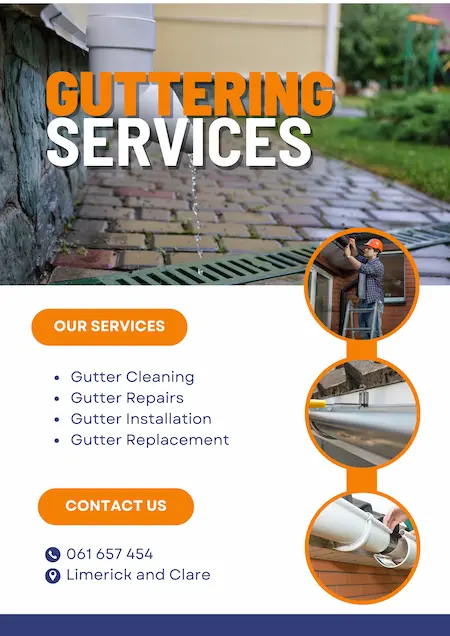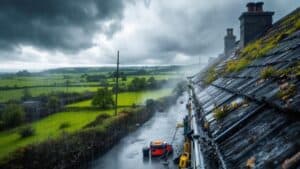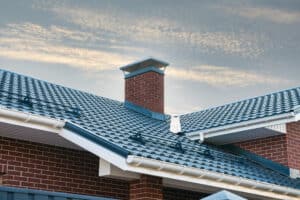Table of Contents
ToggleWhat gutter problems are silently damaging your property and threatening your largest investment? Leaking joints, sagging sections, and blockages might seem minor, but can lead to foundation damage, basement flooding, and fascia rot that costs thousands to repair.
At Guttering Services, we solve gutter problems for homeowners across Limerick and Clare every day. Our experience shows that most costly water damage begins with small, easily repairable gutter issues that go unnoticed until they cause significant structural damage.
This comprehensive guide identifies the warning signs of common gutter problems, explains their potential consequences, and provides practical solutions that protect your property. We’ll show you which issues you can safely address yourself and which require professional attention to prevent expensive damage.
Contact Guttering Services today for a free gutter inspection to identify and resolve problems before they compromise your home’s structural integrity.
Key Takeaways
- Regular cleaning is crucial to prevent blockages and ensure optimal gutter function.
- Promptly addressing issues like sagging, leaks, or improper slope is essential to prevent further damage.
- Proper installation and slope are vital for effective water drainage.
- Consulting a professional is recommended for severe gutter problems.
How to Repair Sagging Gutters?
Sagging gutters are more than just an eyesore; they can lead to significant problems for your home. When gutters droop, they can no longer effectively channel water away from your roof and foundation. This can result in water overflow, damaging your fascia and potentially causing foundation issues.
To fix sagging gutters, you’ll need to identify the underlying problem. Start by cleaning out any debris clogging the gutters. Then, inspect the gutters for holes or damage, repairing or replacing any affected sections. Ensure the gutters have the correct slope by using a level and adjusting as needed. Tightening loose screws or adding additional hangers can help reinforce the gutter’s structure.
Regular gutter maintenance is crucial to prevent sagging and other issues. By clearing debris and conducting routine inspections, you can protect your home from water damage and prolong the life of your gutters.
How to Fix Leaking Gutters?
Leaky gutters pose a significant threat to your home’s structural integrity. When rainwater isn’t properly channeled away from your foundation, it can seep into cracks, causing erosion and potentially leading to costly foundation repairs. Additionally, stagnant water in gutters can create a breeding ground for mosquitoes and other pests.
Improper gutter slope is another culprit behind leaks. Water should flow smoothly towards downspouts. If your gutters aren’t angled correctly, water can pool, causing overflows and potential damage.
To address leaks, carefully inspect your gutters for holes, cracks, or loose connections. Seal these areas with gutter sealant or waterproof caulk. Ensure all screws and nails are securely fastened. Regular gutter cleaning is essential to prevent clogs that can lead to leaks and overflows. By taking proactive steps to maintain your gutters, you can protect your home from costly water damage.
How to Adjust Improper Gutter Slope?
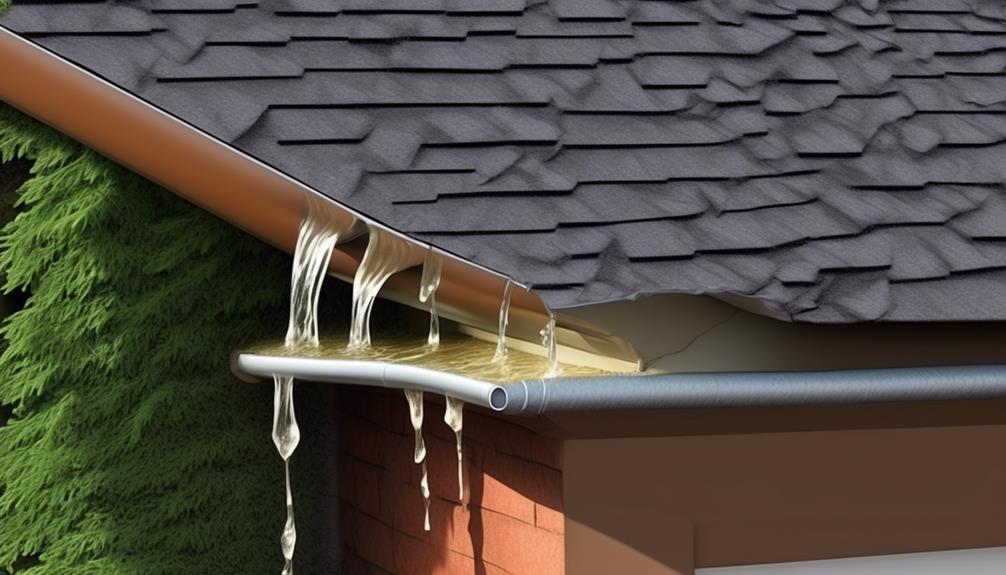
Improper gutter slope is a common issue that can lead to a cascade of problems. When gutters lack the necessary incline, water stagnates, causing a breeding ground for mosquitoes and potentially damaging the gutter itself through rust and corrosion. Moreover, overflowing gutters can lead to water damage on your home’s exterior, foundation issues, and erosion in your landscaping.
Correcting the slope involves carefully removing and reinstalling the gutters. A general guideline is to maintain a downward slope of approximately half an inch for every ten feet of gutter length. For longer gutters, consider a slight pitch towards the center to ensure efficient water drainage towards both ends. Using a level is crucial for achieving the correct angle.
By taking the time to ensure proper gutter slope, homeowners can protect their property from water-related damage and extend the life of their gutter system.
What to Do to Avoid Clogged or Blocked Gutters?
Clogged gutters pose a significant risk to your home’s structural integrity. When leaves, twigs, and other debris accumulate, water cannot flow freely, leading to a cascade of problems. Overflowing gutters can saturate the ground around your foundation, causing erosion and potential structural damage. Additionally, the weight of accumulated debris can cause gutters to sag or pull away from your home.
To prevent these issues, regular gutter cleaning is essential. While this task can be time-consuming and messy, it’s crucial for maintaining the health of your home. Gutter guards can also help reduce the frequency of cleaning, but they are not entirely foolproof.
If your gutters are severely clogged or damaged, professional cleaning or replacement may be necessary.
How to Prevent Gutter Damage?
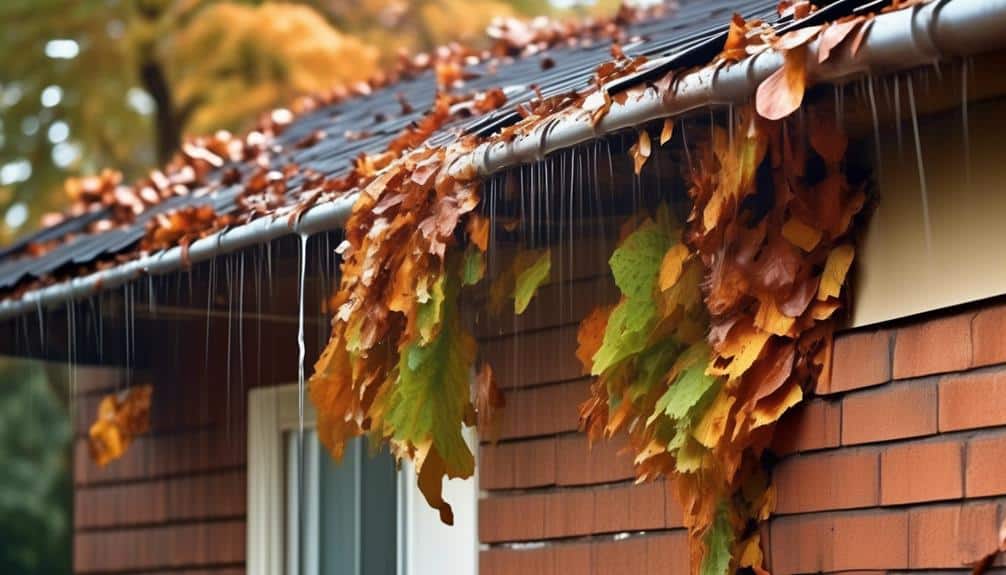
Damaged gutters can lead to a host of problems for your home. Leaky gutters can cause water to infiltrate your home’s foundation, leading to costly repairs. Clogged gutters can lead to overflows, damaging your siding, landscaping, and potentially causing foundation issues.
Common gutter problems include leaks, sagging, and clogs. These issues can often be addressed with simple repairs like tightening loose screws or clearing debris. However, severe damage such as corrosion or structural issues may require professional replacement.
Regular gutter maintenance is crucial to prevent costly repairs. Cleaning out debris, checking for leaks, and ensuring proper slope are essential for maintaining optimal gutter function.
How Can I Prevent Rain Gutter Problems by Choosing the Best Materials?
Choosing the right materials for your rain gutters is essential for long-term performance and minimal maintenance. Durable options like stainless steel, aluminum, or vinyl are highly recommended due to their resistance to corrosion and harsh weather conditions. By investing in quality materials, you can significantly reduce the likelihood of leaks, clogs, and other gutter-related issues, saving both time and money in the long run.
Frequently Asked Questions
Heavy rainfall can expose gutter system limitations that aren’t noticeable during light precipitation. Overflowing gutters typically result from blockages in downspouts, inadequate gutter capacity, improper installation angles, or landscape drainage issues.
Prevent overflow by implementing regular cleaning schedules, ensuring proper installation pitch, upgrading to larger gutters when necessary, and installing quality gutter guards. These preventative measures protect your foundation, landscaping, and exterior walls from water damage during severe weather.
Seamless gutters eliminate most joint-related leaks but still require proper maintenance to function effectively. Despite their advantages, these systems can experience sagging from improper bracket spacing, material deterioration in harsh weather, and blockages that affect water flow.
Professional installation and maintenance are recommended for seamless gutters as their specialised construction requires equipment and expertise that most homeowners don’t possess. When properly installed and maintained, seamless gutters outperform sectional systems in longevity, appearance, and leak prevention.
Failing gutters display several warning signs that indicate replacement or repair is needed. Watch for sagging sections, visible water leakage during rainfall, improper slope causing standing water, and accumulated debris that prevents proper drainage.
Regular inspections after storms and seasonal maintenance prevent minor issues from developing into costly repairs. Address these warning signs promptly to protect your property from foundation damage, basement flooding, and exterior wall deterioration.
Water flow problems in gutters stem from several identifiable issues that affect system performance. Common causes include debris accumulation blocking water passage, improper installation pitch that prevents gravity flow, undersized gutters for your roof area, and corrosion creating uneven surfaces.
Insufficient downspouts or improper spacing force too much water through limited drainage points, while neglected maintenance allows problems to compound over time. Address these issues through regular cleaning, proper system design, and timely repairs to restore effective water management.
Conclusion
Alright, let’s talk about the headache that is rain gutter issues.
If you’ve got gutters that are sagging, leaking, sloping all wrong, clogged up, or just plain damaged, you’re looking at a recipe for some serious home headaches. We’re talking about the kind of trouble that can mess with your home’s foundation, kick up soil erosion, and stick you with a hefty repair bill.
The trick to avoiding this mess is to keep on top of gutter maintenance, make sure those gutters are clean, and fix any problems before they turn into a disaster. If you let those gutter woes slide, you could be opening up your wallet for even more painful costs down the line.


